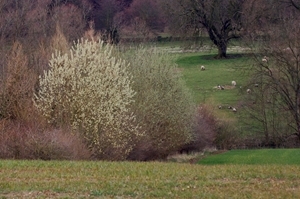The pussy willow
 Once March arrives we can start to keep a look out for pussy willows coming into flower. Their easily recognisable light grey, oval-shaped, furry male catkins are meant to resemble a cat’s paw, hence the name “pussy”. They also used to be known as goslings, which seems to have fallen out of favour somewhat, but I love as they really do resemble miniature, newly hatched geese! Eventually these catkins burst open with golden yellow pollen. Female catkins are longer, with a silvery green appearance and because pussy willow is what is called a dioecious plant, male and female flowers grow on separate trees.
Once March arrives we can start to keep a look out for pussy willows coming into flower. Their easily recognisable light grey, oval-shaped, furry male catkins are meant to resemble a cat’s paw, hence the name “pussy”. They also used to be known as goslings, which seems to have fallen out of favour somewhat, but I love as they really do resemble miniature, newly hatched geese! Eventually these catkins burst open with golden yellow pollen. Female catkins are longer, with a silvery green appearance and because pussy willow is what is called a dioecious plant, male and female flowers grow on separate trees.
Pussy willow is in fact a country name for the goat willow (Salix caprea) and is also commonly used to describe the grey willow (Salix cinerea), as the two species are incredibly similar and both have the pussy-like catkins. What is more, they quite often hybridise with each other. If that’s not confusing enough, both species are also sometimes referred to as sallows, with the goat willow being known as ‘great sallow’ and grey willow as ‘common sallow’. You can perhaps see now why I like to call them all pussy willows, especially as most folk will know which tree you are talking about without trawling through the botanical niceties!
Pussy willow is native to the UK, most of Europe and also parts of Asia. You can find this little tree, which grows no bigger than 10 metres tall, just about anywhere that is not too drought-prone, as along with most willows, it likes to keep its feet in the damper soils.
Pussy willow is a hugely important plant for providing an early spring source of pollen and nectar for many species of insect and a good number, including the stunning purple emperor butterfly, also rely on the foliage as a food source.
It is, of course, not only the wildlife that owes a debt to this group of trees: the willow or Salix family. We too are indebted to willows for giving rise to the world's most widely used medicine. The ancient Egyptians and many other old civilisations used willow bark for rheumatism and headaches. In 1763, Edward Stone, a vicar from Chipping Norton in Oxfordshire, made the first scientific study of the effects of powdered willow bark when he treated patients suffering from rheumatic fever. The active ingredient he was investigating was salicin, which eventually led to the manufacture of acetyl salicylic acid, better known as aspirin.
You don’t need to chew the bark, though. If you have a headache or feel stressed out, just find a pussy willow tree in full flower, rest against its trunk and listen to the hum of bees in the boughs above. All will soon be cured!
Peter Thompson
Advisory
Read more from Peter Thompson at the Fresh from the Field blog.

Download Peter Thompson's essential 26-page book, featuring beautiful photography and detailed profiles of Britain's wildlife
Download FREE >